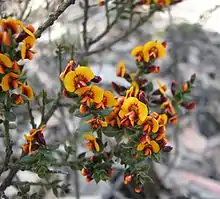Daviesia ulicifolia
Daviesia ulicifolia, commonly known as gorse bitter pea, is a small to medium sized Australian shrub, reaching two meters in size.[2] Its leaves may be oval or elliptical, and terminate in a sharp point.[2] Daviesia ulicifolia has yellow or red pea flowers, complete with keel, wings, and standard. Flowering occurs from August to December depending on altitude, with flowering occurring later in the season at higher altitudes.[3] The fruit is a pod, and is usually formed between September and January.[3]
| Daviesia ulicifolia | |
|---|---|
 | |
| Scientific classification | |
| Kingdom: | |
| (unranked): | |
| (unranked): | |
| (unranked): | |
| Order: | |
| Family: | |
| Genus: | |
| Species: | D. ulicifolia |
| Binomial name | |
| Daviesia ulicifolia | |
| Synonyms | |
| |
This species was first formally described by English botanist Henry Cranke Andrews in 1803 in The Botanist's Repository for New, and Rare Plants.[1]
Habitat, Distribution and Ecology
Daviesia ulicifolia is a drought tolerant shrub, commonly found in dry sclerophyll forests in most of Australia.[2] These forests tend to undergo bushfires every four to twenty years.[4] A bushfire can remove over 70% of the available nutrients from the soil. Plants that exist in areas of frequent bushfire are often adapted to growing with low levels of nutrients. Daviesia ulicifolia, like many Fabaceae, can grow in soils with low levels of the nutrient nitrogen, by forming the symbiosis of nodulation with nitrogen fixing bacteria.[5] This promotes the growth of Daviesia ulicifolia in soils with low nitrogen as well as accumulating nitrogen into the ecosystem, restoring part of the nitrogen lost in previous bushfires. Daviesia ulicifolia is also a nesting site for small birds.[6]
Subspecies
A number of subspecies of Daviesia ulicifolia are currently recognised:
- D. ulicifolia subsp. aridicola G.Chandler & Crisp
- D. ulicifolia subsp. incarnata G.Chandler & Crisp
- D. ulicifolia subsp. pilligensis G.Chandler & Crisp
- D. ulicifolia subsp. stenophylla G.Chandler
- D. ulicifolia subsp. ruscifolia (A.Cunn. ex Benth.) G.Chandler & Crisp
- D. ulicifolia Andrews subsp. ulicifolia
References
- "Daviesia ulicifolia". Australian Plant Name Index (APNI), IBIS database. Centre for Plant Biodiversity Research, Australian Government, Canberra. Retrieved 19 June 2010.
- "Daviesia ulicifolia". www.anpsa.org.au. Retrieved 8 December 2019.
- "Daviesia ulicifolia". www.anbg.gov.au. Retrieved 8 December 2019.
- Reid, James; Hill, Robert; Brown, Michael; Hovenden, Mark (2005). Vegetation of Tasmania. Tasmania: Australian Biological Resources Study. p. 249. ISBN 0-646-44512-X.
- Thrall, Peter; Laine, Anna-Liisa; Broadhurst, Linda; Bagnall, David; Brockwell, John (2011). "Symbiotic Effectiveness of Rhizobial Mutualists Varies in Interactions with Native Australian Legume Genera". PLOS ONE. 6 (8): e23545. Bibcode:2011PLoSO...623545T. doi:10.1371/journal.pone.0023545. PMC 3162553. PMID 21887270. S2CID 12248740. e23545.
- "Daviesia ulicifolia. gorse bitter pea - Diversity Native Seeds". diversitynativeseeds.com.au. Retrieved 8 December 2019.
